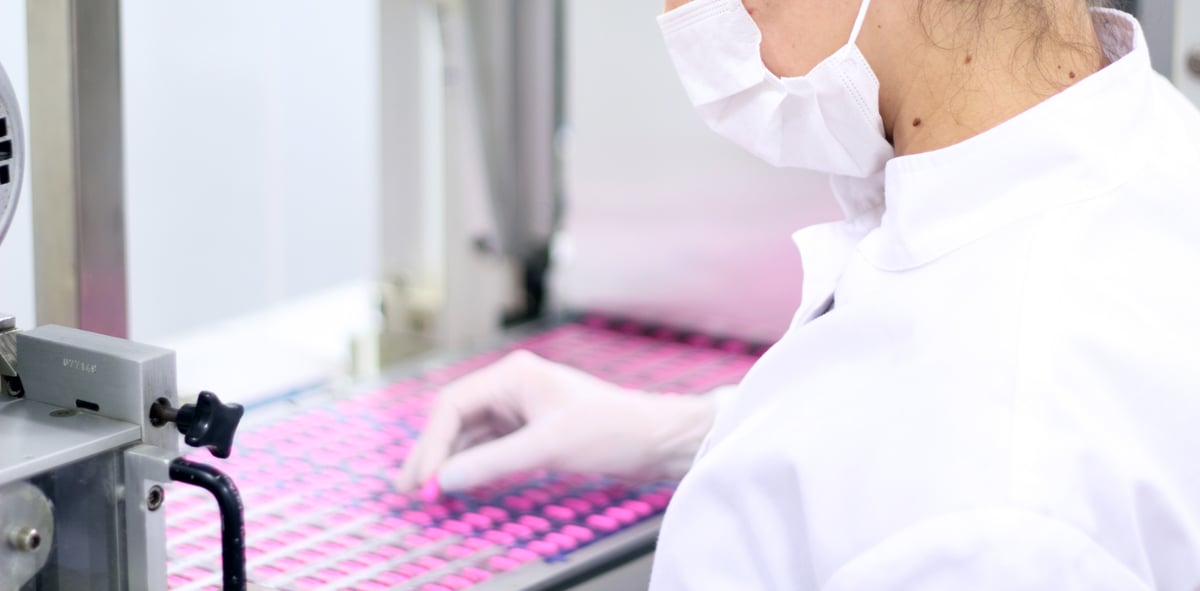In many cases, individual consumers cannot verify the quality of products that can significantly affect their health and safety. Instead, they rely on manufacturers and distributors to follow a strict set of practices to consistently manufacture, store, and distribute high quality products.
These practices, commonly known as “good practices,” or “GxP” for short, encompass a wide range of guidelines companies must follow to adhere to the quality and regulatory standards used in quality-sensitive industries.
Unfortunately, many companies unknowingly fall short when it comes to implementing practices designed to minimize risk and ensure consumer safety. Such examples have become increasingly common, with the U.S. Food and Drug Administration (FDA) issuing five times as many warning letters for violations of good manufacturing practices in the pharmaceutical industry in 2018 compared to 2015. (According to the FDA, this was due to a rise in targeted inspections of “higher risk” facilities.)
These violations can have significant consequences for consumers and companies alike, leading to massive product recalls, lost revenue, government fines and expensive lawsuits.
In the case of FDA regulations, such violations can also prevent the approval of new drugs or supplements, and can even block imports into the U.S. In certain cases, non-compliance with GxP is also compounded with intentionally deceptive acts, which could have been more easily uncovered by full adherence to good practice guidelines.
Egregious violations can result in heavy fines, and the public nature of the FDA violation notice, known as a “Form 483” further punishes manufacturers.
In this article, we take a closer look at the core components of GxP, how these apply to heavily regulated industries, and what companies operating in these spaces can do to ensure that they follow essential good practices and maintain the trust of both regulatory bodies and the public alike.
Core components of GxP
 GxP guidelines are generally, but not always, applied in situations where the final product has direct consumer contact, for example in pharmaceuticals, medical devices, and food — or where extremely high quality is required to ensure safety and performance, such as in the aviation.
GxP guidelines are generally, but not always, applied in situations where the final product has direct consumer contact, for example in pharmaceuticals, medical devices, and food — or where extremely high quality is required to ensure safety and performance, such as in the aviation.
The “x” in GxP refers to the specific area of good practice. For example, guidelines exist for areas including laboratories (GLP), distribution (GDP), manufacturing (GMP), and many others. A “c” can be used (“cGMP”) to denote the most current version
of the standard.
Regardless of the space in which GxP is used, some general themes appear in all areas. Following these standards should be considered an essential part of a comprehensive approach to ensure product safety and security, from testing, to manufacturing, to distribution.
While specific guidelines exists for some industries, all GxP systems revolve, in some form, around the following pillars:
- Traceability: Recording sufficient information to recreate the entire process of generating a material or product. For example, maintaining records pertaining to raw material batches, equipment qualification, process validation, and environmental conditions.
- Accountability: Maintaining records to identify who participated in a process, and to ensure and record that employees at all levels are properly trained and qualified. For example, logging the operator of a certain piece of machinery, or keeping complete training records.
- Data integrity: This principle underlies the other two pillars. According to FDA guidance, data integrity refers to the “completeness, consistency, and accuracy of data”. Data collected for GxP purposes should follow the ALCOA rule: attributable, legible, contemporaneously recorded, original or a true copy, and accurate. Data security measures should also be in place.
The 5 P’s of GxP
A useful framework to implement traceability and accountability standards is known as the “5 P’s” of GxP. These refer to:
- People:
- Are the people involved in the process properly trained and qualified for their role, and are records of training and performance assessments kept? Do they have clear roles and responsibilities? Are they trained in the principles of GxP?
- Is a good hygiene policy in place, including hygiene, sanitary practices for employees and equipment to prevent contamination by employees, and has this policy been validated to work?
- Is there a system for individual employees to raise potential quality issues? Is there a system of third parties- like suppliers and contractors- to be certified or approved?
- Is there a system for reviewing training methods?
- Does a general quality policy or mission statement exist?
- Procedures:
- Do standard operating procedures (SOP’s) exist for critical parts of the process, and are they easily accessible and regularly reviewed?
- Are processing excursions or deviations from an SOP documented and investigated, and are corrective actions recorded?
- Products & Primary (Raw) Materials:
- Is there a standard method for sampling and testing the finished product, and do specifications exist for the test results?
- Are there specifications and testing programs for raw materials and intermediate materials?
- Do systems exist to approve or reject raw materials, in-process and final products?
- Is the full master formula documented?
- Premises & Equipment
- Is the facility clean and well-maintained? Is the facility designed to make cleaning and maintenance easy, while preventing cross-contamination?
- Is the processing/warehousing environment properly monitored and controlled, and are records of environmental conditions maintained and reviewed? Keep in mind that, for pharmaceuticals and foods, GMP regulations apply to both production and storage facilities.
- Are safety processes in place, and do staff have access to necessary personal protective equipment?
- Where relevant, are processes documented to qualify, inventory, maintain, monitor, calibrate, clean, replace, and quarantine equipment? Are these processed validated to achieve their intended purpose?
- Are maintenance and calibration procedures logged?
- Processes
- Is the overall process clearly documented and is it consistently followed?
- Is the process validated? In the context of GMP, the FDA defines process validation as “the collection and evaluation of data, from the process design stage through commercial production, which establishes scientific evidence that a process is capable of consistently delivering quality product”.
- Has equipment or utilities that support the production process been validated?
- Has any software used in the process, or in the product itself, been validated?
- Have the critical steps in the process been identified?
- Is there change control systems (equipment, software, utility, documentation, process) in place to ensure there is adequate documentation and control over any changes?
Industry examples
GxP is used extensively in the pharmaceutical industry, where it is needed to ensure safety and effectiveness. GxP guidelines cover almost all stages of the life cycle of a pharmaceutical product. The most critical of these include good clinical practice, which covers testing on human subjects, good laboratory practice, which covers non-clinical testing, general good manufacturing practice, as well as good storage and distribution practices.
Medical devices fall under a similar set of regulations. In certain cases, the guidelines for good laboratory practice apply, for example when preclinical data is being collected to determine the safety of a product. In the US (and for products imported to the US), the FDA regulates clinical testing through good clinical practice, and manufacturing through GMP regulations written specifically for medical devices, which will be discussed in more detail below.
In food and agriculture, GxP is mainly used to prevent foodborne illnesses and to prevent cross-contamination by allergens. For example, the FDA requires that any personnel who “manufacture, process, pack or hold food” should be fully trained and qualified under the GxP principles discussed above. Good agricultural and handling practices also exist specifically for fruits and vegetables, which in the US have been harmonized with FDA regulations.
Specific GxP guidelines are used in the aerospace industry to ensure the safety and airworthiness of aircraft. Guidelines exist for OEM’s, part suppliers, distributors, and entities responsible for maintenance. These standards usually overlap with more comprehensive programs which also aim to optimize manufacturing efficiency and reduce cost.
One thing that the above examples have in common is that they are highly regulated industries where even small deviations in quality could have disastrous consequences for consumer safety. However, the same GxP principles can also be applied in other, less regulated industries, for example, non-sterile manufacturing, to effectively improve product consistency and quality when it reaches the consumer.
Regulatory and Compliance Requirements
Pharmaceuticals
In the US, the FDA ensures GxP principles are being followed in the pharmaceutical and medical device industries by publishing and maintaining thorough standards, and by auditing manufacturing and testing facilities. In Europe, these responsibilities are shared between the European Medicines Agency (EMA) and national regulatory agencies of member states.
In the case of the FDA, in recent years this has included a significant number of inspections of overseas facilities which export drugs and raw materials into the US, and targeted inspection of facilities that are considered to be “high risk.”
For pharmaceuticals, US federal regulations regarding quality, including GxP, are included in CFR Title 21, Chapter 1 (for the EU, GxP guidelines can be found in EudraLex, Vol. 4). The key regulations in this area include:
- CFR 21 Parts 210 and 211, for pharmaceutical manufacturing, including storage and distribution
- Additional resources are available from the EU on the distribution of drugs and active ingredients, and from the WHO on transporting and storing temperature-sensitive drugs.
- CFR 21 Part 820, for medical devices
- Other important information for medical devices includes specific guidance issued by the FDA for the validation of software related to medical devices, and ISO 13485, which will replace CFR 21 part 820 to harmonize and simplify global regulations.
- CFR 21 Part 11, which specifically covers electronic record-keeping
Food and Agriculture
GxP in the food and agriculture industries has evolved significantly in the last 10 years, in large part due to the passage of the Food Safety Modernization Act (FSMA) in 2011, and increased concern over foodborne illnesses.
The relevant regulations for the manufacture and distribution of food in the US can be found in the FSMA, with specific GxP guidelines given in CFR 21 Part 110 (manufacturing and distributing food), Part 111 (dietary supplements), and 112 (produce).
The USDA also publishes standards for good agricultural practices (GAP) and good handling practices (GGP), which have been aligned with the FSMA. Produce suppliers can volunteer to be audited by the USDA for adherence to these standards, which can be used as an indicator for readiness for FDA inspections.
Aerospace
In aerospace, the most significant guidelines are found in the AS9100 standard, and the related AS9110 and AS9120 standards which apply to aviation repair and distribution, respectively. These are based on the ISO 9001 standard, with narrowing and modification for the specific concerns of the aerospace industry. The standards are maintained by the SAE (Society of Automotive Engineers).
Certification against these standards, which is voluntary, is done by third-party organizations. The FAA also publishes additional guidelines.
Tips for Meeting/Maintaining GxP compliance
 Regardless of industry, the foundation of any successful GxP system is accurate, detailed record keeping and documentation. Below, we offer our suggestions:
Regardless of industry, the foundation of any successful GxP system is accurate, detailed record keeping and documentation. Below, we offer our suggestions:
1. Record data according to the ALCOA rule (automated monitoring/mapping of the production or warehouse environment, controlled holding chambers, and other process conditions can be a way to ensure this is done).
2. Store data in a secure, organized way. Make a diagram of the flow of data during the process, and list possible risks and mitigation strategies for data integrity.
3. Document all processes and procedures using SOPs (including the process for writing SOPs). Have systems in place for reviewing these SOPs.
4. Properly train employees at all levels. This includes providing employees with a clear understanding of their role in the process.
5. Systematically and continually validate equipment and procedures. Many GxP violations involve improper validation, or the use of un-validated procedures.
6. Perform regular internal audits that mimic as closely as possible the “official” audits by the relevant regulatory organization. Food and drug manufacturing and warehousing facilities, in particular, should be prepared for periodic FDA inspections at any time. For an example checklist, see this document published by the International Society for Pharmaceutical Engineering.
Conclusion
Understanding, implementing, and maintaining GxP standards is an effective way to ensure customer safety and confidence. Furthermore, following GxP standards is a barrier to entry in highly regulated industries. In many cases, rigorous guidelines have already been established by regulating bodies, giving companies the roadmap they need to effectively maintain compliance.
Use of GxP methods, which involve highly detailed data collection and recordkeeping, can be made much easier by selecting the right partner. Dickson has the experience and expertise to help you navigate the process. Contact our team of trained professionals today for a consultation.
About the author: Before coming to Dickson, Director of Services Antoine Nguyen spent more than 18 years in quality and validation roles in the pharmaceutical and medical device industries.


